
A Gunnison Valley Health clinician walks a mountain trail on a day off (GVC)
Gunnison Valley Health’s hospital and clinics are tucked into the Rocky Mountains, where many of the staff hike, bicycle and ski in their free time. It prides itself on offering all its clientele exceptional, equitable care, so some were both surprised and disheartened to hear on the grapevine that some patients felt left out.
After some digging, the clinic found out that residents whose preferred language is Cora, an indigenous language in Mexico, were dissatisfied with their experience due to communication barriers and had even travelled outside Gunnison Valley to get medical care. Given the undercurrent of discontent, leaders from the healthcare provider decided to reach out to the Latino community, including Spanish-speaking residents, to understand what the criticisms were and how they could better serve them, as part of a project for CCI’s Colorado Health Innovation Community.
“The Hispanic community was upset. We wanted to know why they felt excluded,” says Nicole Huff, chief nursing officer at Gunnison Valley Health. “We wanted to learn where we were falling short and how we could change the perception of the community when it came to the provision of equitable and inclusive care.”
It was important to simply listen, says Huff, who formerly served as Gunnison Valley Health’s emergency department director. She had already fielded a complaint in the emergency department that was sobering: A teenager with respiratory distress during the height of COVID was isolated—per hospital protocol for all patients. But the child and her mother didn’t understand why they were placed in a segregated room—like a cage, they said—and subjected to a long wait. They were not familiar with an emergency department’s triage system or the pandemic policies around patients presenting with symptoms of a potential infection. They thought it was because they were brown skinned, Huff later learned.
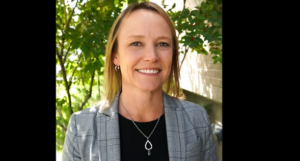
Nicole Huff, RN, MBA, MSN, CBM, is director of nursing at Gunnison Valley.
Due to language barriers that impeded communication, the patient and her mother perceived discrimination based on the color of their skin and their preferred language. “Because we didn’t offer care in the mother’s language, there were misunderstandings and misperceptions and the underlying feeling was that we were treating the patient differently because of her ethnicity,” says Huff. “The daughter did speak English but she was very sick. So we couldn’t easily explain what we were doing and why and she carried the feeling that she was treated poorly for some time.” Huff understood that while the patient received the same standard of care of anyone entering the hospital, it was the perception of inferior care that lingered in the patient’s mind – and had to be addressed.
At the community listening session, attended by around 20 area residents, health center staff learned that there were other troubling issues to address around language barriers. They heard about a pregnant woman who didn’t understand that she had had a miscarriage. She thought doctors were trying to remove her uterus, which she understandably found terrifying. She also went home without really realizing that her baby had died and that she had had a dilation and curettage procedure. “That was really hard to hear,” recalls Huff. “But we listened and we learned. That situation could have been solved by having interpretive services available.” During the two-hour session it became clear what the organization wasn’t doing well. The good news: They were determined to remedy the situation, they already had some resources in place, and some of the issues were relatively easy to fix.
Accommodating a language of choice
Residents expressed concerns at every stage of their healthcare experience. The healthcare team heard all kinds of complaints and discovered that in some instances simply asking every patient what their preferred language is can help ensure that patients receive the kind of timely language assistance they needed. Residents were vocal about their frustrations with not being able to communicate with caregivers, being hung up on while on the phone with health team members, not understanding instructions after visits, and not being able to schedule appointments, among other issues. About 10 to 15 percent of Gunnison Valley Health’s patients’ preferred language is Spanish, and around 2 percent prefer Cora.
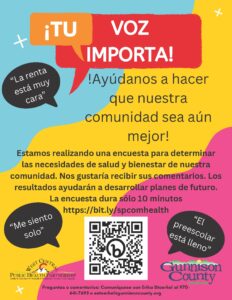
The health organization set out to determine how it could best provide care if Cora was a patient’s preferred language. It also wanted to know how it could assist this population, which had limited proficiency in spoken and written English, navigate the health system. Cora is part of the Uto-Aztecan language family used by around 30,000 people. It is spoken by the ethnic group that is known widely as the Cora, but who refer to themselves as Naáyarite, since they come from the state of Nayarit in central western Mexico.
The listening session made clear to the staff that Gunnison Valley Health has had challenges communicating with Cora speakers seeking care, including repeat visits to the emergency department and missed follow-up appointments with primary care or specialized care. The CHIC project wanted to remedy this head-on by improving Interpreting services and patient experience in all areas of the organization, from admission to discharge to follow-up care. But how to get started?
Developing a strategy for equity
Gunnison Valley Health comprises 17 clinic locations and a licensed 24-bed, short-term, critical access hospital owned and operated by the County of Gunnison. The town is a premier rural recreational region in Colorado’s Rocky Mountains. The population of Gunnison is just over 17,000; residents are largely white and the area is a popular location for second home owners. The health center is the area’s safety net provider for local residents.
The health network settled on a multi-pronged approach to improving communication between limited-English speakers and health center staff:
- Gunnison Valley Health implemented an “ask” at admission around preferred language. When either Cora or Spanish is requested, staff deployed the appropriate interpreters or service, including one-on-one interpreters or tablet translation services. The organization also invested in more iPads for the latter.
- It hired a multilingual patient navigator (proficient in Cora, English, and Spanish) who helps patients as they traversed the healthcare system (more on this later).
- It educated staff about the language services available and provided bilingual employees (in this case Spanish speakers) the opportunity to attend interpreting certification classes. This added a modest bump to their hourly wage and helped to beef up the staff’s interpretation abilities.
- Providers, the health tech navigator and others kept talking with the community, soliciting feedback and offering sessions on whatever healthcare concerns non-English speakers wanted help with. This included dealing with the financial side of healthcare, triage protocols of emergency departments, how to interpret lab reports, and women’s health concerns. Providers, the patient navigator, translators, and other organization staff share educational information and solicit feedback at these meetups.
Fostering cultural connection versus culturE clashes
The clinic’s journey to cultural connection underscores the need to think outside the box.
Some of the solutions were relatively small and simple, but they made a huge difference to the patients they helped. Staff at all points of entry were trained on how to hold a three-way phone conversation with a translator looped in, which proved vital for scheduling appointments. (It turned out that some of what patients thought were “hang ups” were actually frontline staff attempting to dial in translation services.)
At the hospital bedside, providers were instructed to use iPads or in-person translation services for Spanish speakers to give instructions, plans for care, and follow-up information in a patient’s preferred language. The iPads offer 30 different language translation services, but Cora, which is spoken-only language without a written counterpart — is not one of them.
The health center learned that for the Cora-speaking community, face-to-face interpretive services were preferred. Patients felt more supported and safer with that level of intimacy. The community also weighed in on a specific interpretive service to contract with, which the health organization agreed to use. However, the budget for professional translation services has mushroomed from $12,000 a year to $130,000—around $86,000 over increased budget projections, so the health organization is rethinking this default practice now.
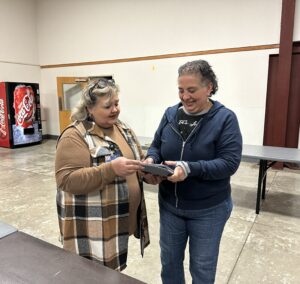
Multilingual patient navigator Cinthia Saenz (left) helps Spanish-and Cora-speaking patients with everything from appointments to billing (Credit: Gunnison Valley Health)
In the meantime, with the help of funds from a private foundation, Gunnison Valley Health hired a part-time patient navigator, Cinthia Saenz, who will transition to full time come January 2024. Saenz helps Spanish- and Cora-speaking patients with everything from scheduling and registration to appointments and billing.
Saenz, a certified medical interpreter, is a longtime Gunnison Valley resident who has raised three children in the area. She’s also an immigrant who moved from Ciudad Juárez, Chihuahua, in Mexico to Gunnison 20 years ago, so she brings lived experience to her role. Professionally, she has served as vice president of Inmigrantes Unidos de Gunnison, a nonprofit organization that helps the immigrant community integrate successfully into the valley. Saenz also has personal ties to the health system both as a patient and a member of the volunteer patient and family advisory council. Her experiences as a patient are what sparked her desire to work in the health system and support her community by improving access to access local services.
Patients sing her praises. “Cinthia was great — she was able to help me understand where I needed to go and when,” one said. Says another: “I want to thank the hospital for all the support, the translators are excellent, beautiful people with human warmth.”
There’s more to be done, but the health network is gratified that Spanish-and Cora-speaking patients are happier with the services offered at Gunnison Valley Health. “We have seen great improvements in the care we receive at Gunnison Valley Health,” wrote one satisfied patient. Another added: “I can tell they are really trying.”
In terms of next steps, the organization intends to keep listening and keep educating both staff and patients. It’s open to exploring new tools and rethinking the best way to offer translation services without breaking the budget, perhaps by hiring more multilingual patient navigators. And it wants to keep the goodwill it’s built through this project process going strong.
“Put yourself in your patients’ shoes”
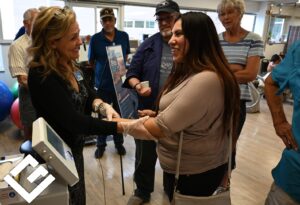
Inside a Gunnison Valley Health facility (GVC Facebook)
The bottom line, says Huff: Put yourself in your patients’ shoes. To get a good sense of what it’s like for a minority culture overwhelmed and confused by the U.S. healthcare system, Huff recommends reading a book a colleague suggested as she dug deep into the importance of cultural competency during research for this effort. The Spirit Catches You and You Fall Down: A Hmong Child, Her American Doctors, and the Collision of Two Cultures is about a refugee family from Laos in Merced, California with a daughter, Lila Lee, who had severe epilepsy.
The award-winning book, first published in 1997, recounts the medical tragedy that befell the family, one that occurred due to an extreme cultural disconnect and the inability of healthcare providers to empathize with patients who value traditional customs and health folkways. The conflict between the spiritually-based Hmong approach and the strictly scientific American approach plays out in real time as the child’s condition worsens and she slips into a vegetative state that continues for 26 years, until her death in 2012. “It really gets to the heart of the role perceptions play in healthcare when different cultures aren’t understood,” says Huff, who dubbed the book a must-read for anyone in the health profession. “It helped me immensely. It helped me to suspend judgement about cultural practices different from my own and to see how language barriers can really impact equitable and inclusive care.”
Lia Lee’s legacy lives on in Merced, where she spent her early life, and beyond. Medical interpreters have increasingly become more commonplace around the country. And at Mercy Medical Center Merced, the current incarnation of Merced Community Medical Center where Lee was first treated, Hmong shamans have been allowed to visit patients and practice a limited number of their traditional arts; the center is also the country’s only hospital-based shaman certification program. (Many Hmong believe that the soul plays an integral role in health and sickness and in life and death, notes author Xenia Shih Bion. Hmong tradition considers most illnesses to be the result of the soul becoming separated from the body because of an accident, a traumatic event, or theft by an angry spirit.) Except for a year when well-meaning but misguided Merced doctors forced her parents to relinquish their daughter to foster care, Lee was devotedly looked after by her parents and her surviving siblings for the remainder of her life. Says Huff: “It was an amazing story and so instructive about navigating these issues with empathy and compassion.”
Lessons Learned
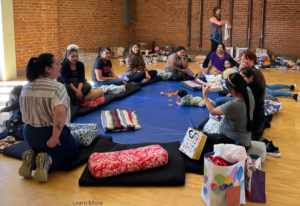
Mountain Mamas baby shower at a Gunnison Valley Health clinic (GVH Facebook )
Communicate, communicate, communicate. Perception is everything. Always explain why the health organization has a specific practice or policy. Understand that patients who are more familiar with medical care outside of the U.S. healthcare system are used to different approaches. Use translation services to make sure that information is getting conveyed accurately and in a timely manner.
Budget carefully around translation costs. The unanticipated skyrocketing expense of professional interpreting services turned out to be unsustainable. Try to get a handle on these expenses upfront and monitor closely.
Proceed with caution when contracting with interpreting services. The community was adamant about which translation service they wanted at the health organization. Given the financial hit, the organization may need to do things differently – a change that may upset the community and will need to be worked out, notes Huff.
Continue to educate staff and patients. This is not a “one and done” deal. Ongoing awareness needs to be built into the program to ensure that limited and non-English speakers’ needs are met when they access healthcare.
Keep an open mind. Patients want their voices heard and need to express their values and beliefs around illness and healthcare. Strive to keep judgments in check and to see concerns from the point of view of the patient and their caregivers. Empathy matters.
Find this useful or interesting? We’re constantly sharing stuff like this. Sign up to receive our newsletter to stay in the loop.

